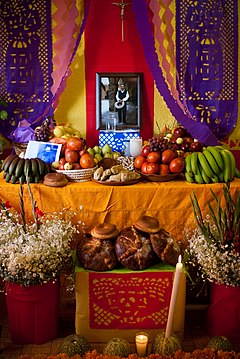Day of the Dead
| Day of the Dead | |
|---|---|

Día de Muertos altar commemorating a deceased man in Milpa Alta, México DF.
|
|
| Observed by | Mexico, and regions with large Hispanic populations |
| Type | Cultural Syncretic Christian |
| Significance | Prayer and remembrance of friends and family members who have died |
| Celebrations | Creation of altars to remember the dead, traditional day of the dead's food |
| Begins | October 31 |
| Ends | November 2 |
| Date | October 31 |
| Next time | 31 October 2017 |
| Frequency | Annual |
| Related to | All Saint's Day |
Day of the Dead (Spanish: ) is a Mexican holiday celebrated throughout Mexico, in particular the Central and South regions, and by people of Mexican ancestry living in other places, especially the United States. It is acknowledged internationally in many other cultures. The multi-day holiday focuses on gatherings of family and friends to pray for and remember friends and family members who have died, and help support their spiritual journey. In 2008, the tradition was inscribed in the Representative List of the Intangible Cultural Heritage of Humanity by UNESCO.
The holiday is sometimes called Día de los Muertos in Anglophone countries, a back-translation of its original name, Día de Muertos. It is particularly celebrated in Mexico where the day is a public holiday. Prior to Spanish colonization in the 16th century, the celebration took place at the beginning of summer. Gradually, it was associated with October 31, November 1 and November 2 to coincide with the Western Christian triduum of Allhallowtide: All Saints' Eve, All Saints' Day, and All Souls' Day. Traditions connected with the holiday include building private altars called ofrendas, honoring the deceased using calaveras, aztec marigolds, and the favorite foods and beverages of the departed, and visiting graves with these as gifts. Visitors also leave possessions of the deceased at the graves.
Scholars trace the origins of the modern Mexican holiday to indigenous observances dating back hundreds of years and to an Aztec festival dedicated to the goddess Mictecacihuatl. The holiday has spread throughout the world, being absorbed within other deep traditions for honoring the dead. It has become a national symbol and as such is taught (for educational purposes) in the nation's schools. Many families celebrate a traditional "All Saints' Day" associated with the Catholic Church.
...
Wikipedia
